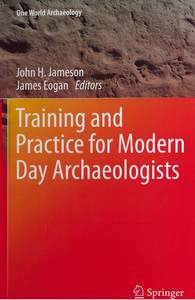Australian archaeology in profile: a survey of working archaeologists
Ulm, Sean, Nichols, Stephen, and Dalley, Cameo (2013) Australian archaeology in profile: a survey of working archaeologists. In: Jameson, J.H., and Eogan, J., (eds.) Training and Practice for Modern Day Archaeologists. One World Archaeology, 1 . Springer, New York, pp. 31-51.
|
PDF (Accepted Author Manuscript)
- Accepted Version
Download (427kB) | Preview |
|
![[img]](https://researchonline.jcu.edu.au/24507/2.hassmallThumbnailVersion/24507_Ulm_2013.jpg)
|
Image (JPEG) (Book Cover)
- Cover Image
Download (160kB) |
|
|
PDF (Published Version)
- Published Version
Restricted to Repository staff only |
Abstract
[Extract] Professional archaeology in Australia has changed profoundly over the last four decades. A dramatic expansion of the cultural heritage management sector has occurred at the same time as significant restructuring of the university and museum sectors. Despite these changes, there are very few data documenting the basic profile of the discipline in Australia. The usefulness of previous surveys is often limited by small sample sizes, limited geographic scope or limited employment sector focus (see Colley 2003; Feary 1994; Frankel 1980; Smith and Burke 2006; Truscott and Smith 1993). Several studies sourcing data from membership records of major associations (e.g. Australian Archaeological Association) also present problems owing to the high levels of avocational membership and the difficulty of assessing the representativeness of the records (e.g. Beck and Head 1990) while others have employed generic data for the higher education sector which are not archaeology specific (e.g. Beck 1994). Many of the most useful datasets were assembled to examine aspects of gender participation rates and were published in the proceedings of the Australian "Women in Archaeology" conference series (Balme and Beck 1995; Casey et al. 1998; du Cros and Smith 1993). Smith and Burke (2006) and Bowman and Ulm (2009) recently reviewed participation rates in academic archaeology and national competitive grant rounds, respectively. All of these data were gathered to create specific indices rather than to characterise the broader discipline. Lydon’s (2002) detailed study of archaeology in the workplace is an exception, although the broad application of its results is limited by its focus on the cultural heritage management sector, low response rate and concentration on Victoria. Similarly, Colley's (2004) and Gibbs et al.'s (2005) analyses of written responses to questions posed at conferences and workshops were limited by sample size and the unstructured nature of the collection instruments.
Limitations of available data were discussed at length at the 2003 Redfern National Archaeology Teaching and Learning Workshop. This very successful workshop provided the direction and framework for a coordinated approach to archaeology teaching and learning and the origins of the Australian National Committee for Archaeology Teaching and Learning (ANCATL) which is now the peak body in this area. The need for baseline data about the discipline was acknowledged at the Workshop as a basic requirement for informed decision making on archaeology teaching and learning issues. This concern was represented in one of the five key resolutions of the Workshop (the Redfern Archaeology Teaching Charter) (Colley 2004: 201) as a commitment to gathering reliable data for benchmarking of a variety of archaeology activities similar to UK survey instrument (cf. Aitchison and Edwards 2003).
The "Australian Archaeology in Profile: A Survey of Working Archaeologists 2004/2005" project described here was an attempt to contribute to this goal, with the aims of (1) building a basic profile of professional archaeology in Australia and (2) defining key archaeology learning and training issues.
| Item ID: | 24507 |
|---|---|
| Item Type: | Book Chapter (Research - B1) |
| ISBN: | 978-1-4614-5528-8 |
| Keywords: | archaeology, Australian Indigenous archaeology, maritime archaeology, historical archaeology, cultural heritage management, employment surveys, qualifications, skill gaps, access, participation, workplaces |
| Copyright Information: | © Springer Science+Business Media New York 2013 |
| Date Deposited: | 14 Jan 2013 02:23 |
| FoR Codes: | 21 HISTORY AND ARCHAEOLOGY > 2101 Archaeology > 210101 Aboriginal and Torres Strait Islander Archaeology @ 70% 21 HISTORY AND ARCHAEOLOGY > 2101 Archaeology > 210108 Historical Archaeology (incl Industrial Archaeology) @ 20% 21 HISTORY AND ARCHAEOLOGY > 2101 Archaeology > 210110 Maritime Archaeology @ 10% |
| SEO Codes: | 97 EXPANDING KNOWLEDGE > 970121 Expanding Knowledge in History and Archaeology @ 100% |
| Downloads: |
Total: 1095 Last 12 Months: 30 |
| More Statistics |



